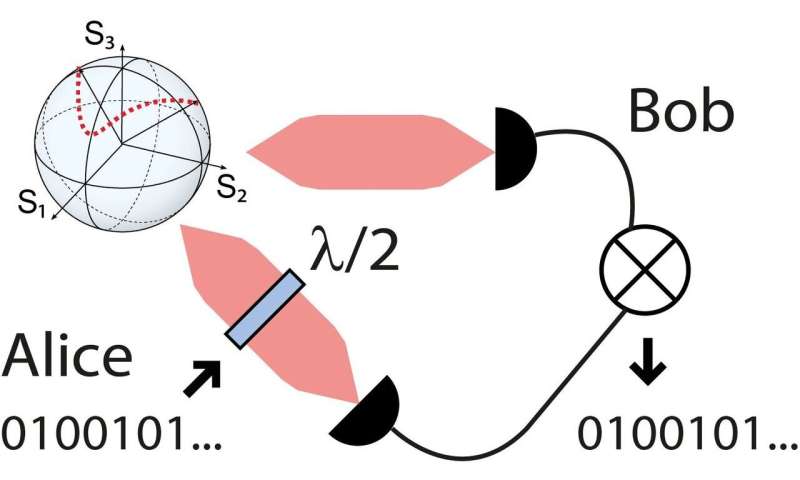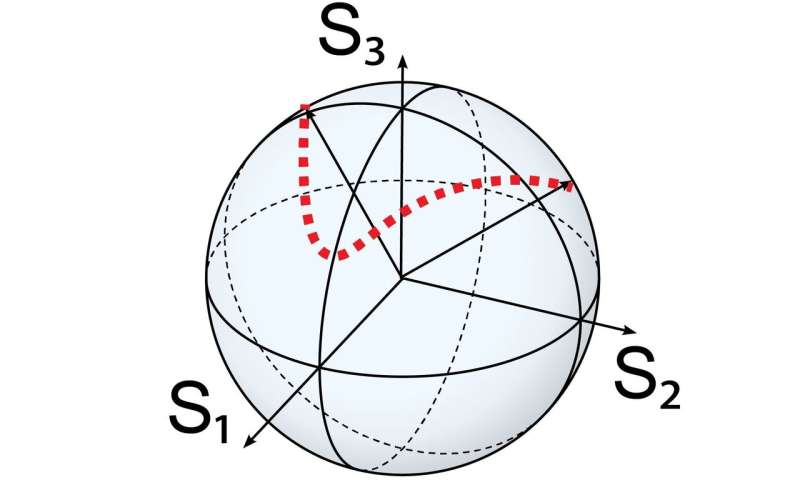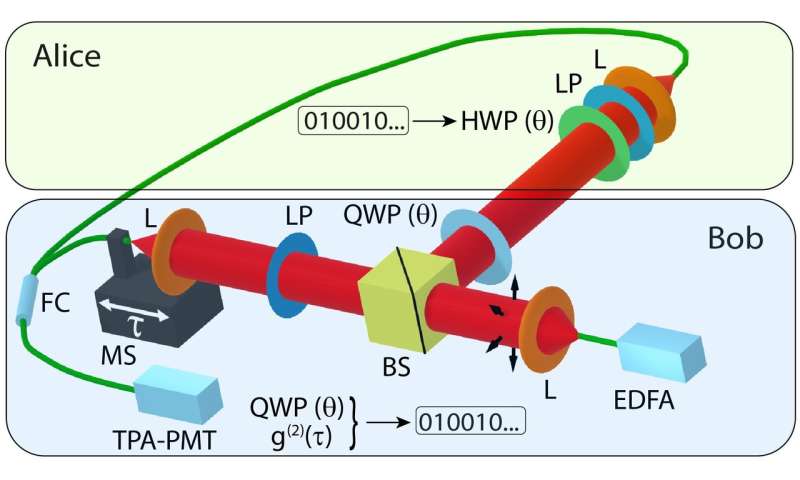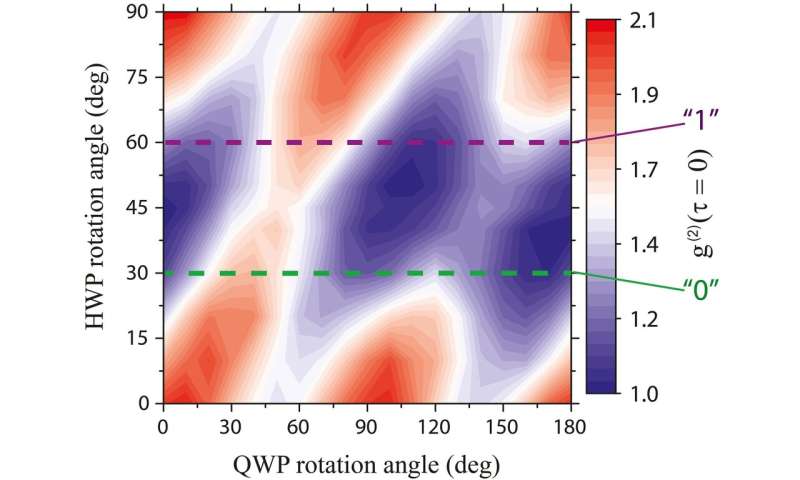Ghost moves towards communication: Correlated unpolarized photons enable camouflaged secure communication

Secure communication is an important and challenging topic for global digital data exchange and ensures the interaction of Internet of Things devices as well as private messaging between two parties. Parallel to the efforts made in the development of quantum computers, secure cryptographic systems are highly important, and novel communication schemes such as quantum cryptography are under development. Apart from quantum cryptography, chaos communication is another area of research that aims to realize the secure transfer of information on the basis of physical laws by exploiting two chaotic lasers and their synchronization, thus providing a measure of security directly on the physical layer.
What might be novel different approaches?
We, a group from Technical University of Darmstadt, have pursued a different approach based on our expertise in chaos communication and in correlated photon metrology. Our idea rests on three scientific concepts: secure communication; quantum optics in the spirit of Hanbury-Brown and Twiss photon correlations, here in the sense of ghost metrology schemes; and classical optics in the spirit of the Stokes polarization formalism and the Poincaré sphere.
Exploiting correlations and unpolarized light
We conceived and realized an approach for a message-encoding scheme between two parties, typically called Alice and Bob, by exploiting a somewhat counterintuitive subject: the dynamic polarization state of unpolarized light.
Unpolarized light can be understood as dynamically occupying all the infinite number of polarization states on the Poincaré sphere, however, within a femtosecond snapshot it is stationary at one specific polarization state on the Poincaré sphere.

This model representation of unpolarized light, together with its thermal emission correlation properties, has been used to camouflage and recover a message, thus realizing ghost polarization communication (GPC). This name has been chosen in analogy to other ghost modalities (GMs), i.e., metrologies that are based on photon correlations, in our case, in the sense of classical twin photons.
At first, we investigated the intensity correlation coefficient g(2)(t) of classical unpolarized, broadband amplified spontaneous emission (ASE) light emitted by an erbium-doped fiber amplifier (EDFA) at a telecom wavelength of 1550 nm by manipulating its instantaneous polarization state, using various polarization optics in the beam paths of a Hanbury-Brown and Twiss-like ghost polarimetry setup using ultra-fast two-photon absorption in a photomultiplier tube. The observed polarization state modifications are not only in excellent agreement with an analytical model based on the Stokes vector dynamics and a Glauber protocol for g(2) (t), but they allowed us to proceed toward the realization of a message encoding scheme by exploiting them.

Toward Ghost Polarization Communication
Half of the classically correlated photon beam is sent via the beam splitter (BS) from Bob to Alice. By changing its instantaneous polarization state using a half-wave plate (HWP, see figure), Alice encodes a message via its angular position and subsequently transmits this message-modified polarization state back to Bob. The camouflaged message can be recovered uniquely by Bob measuring the second-order correlations of the modified instantaneous polarization state with his correlated reference light beam. By using the agreed-upon encoding table of the communication scheme, he is able to retrieve the bit values (zero or one, see figure) of the encoded message from the knowledge of his quarter wave plate (QWP, see figure) angle, and his measured g(2) (t) value. This first proof-of-principle demonstration establishes a camouflaged, secure communication link between two parties directly on the physical layer based on polarization correlations of classical light.

What will the future hold?
GPC complements quantum and chaos cryptography, respectively, thus fertilizing the exchange and discussion between these fields. The analogy to ghost imaging and ghost spectroscopy is expected to promote a deeper understanding that may lead to other real-world applications using GM protocols. The head of the group, Prof. Wolfgang Elsaesser, says, "This is the first time that a GM offers postulated qualitative improvements against non-ghost metrology applications. GPC is only possible due to the recovery of a camouflaged polarization state through correlations. We expect that the realization of this correlated photon modality not only opens new avenues for ghost modalities in general, but also offers new insight into polarization, even more than 175 years after Sir Gabriel Stokes, the father of polarization."
This story is part of Science X Dialog, where researchers can report findings from their published research articles. Visit this page for information about ScienceX Dialog and how to participate.
More information: Markus Rosskopf, Till Mohr, and Wolfgang Elsäßer, "Ghost Polarization Communication", Phys. Rev. Applied 13, 034062 (2020); doi.org/10.1103/PhysRevApplied.13.034062
S. Hartmann, and W. Elsäßer, "A novel semiconductor-based, fully incoherent amplified spontaneous emission light source for ghost imaging", Sci. Rep., Vol. 7, 41866 (2017); DOI: 10.1038/srep41866
P. Janassek, S. Blumenstein, and W. Elsäßer, "Ghost Spectroscopy with Classical Thermal Light Emitted by a Superluminescent Diode", Phys. Rev. Appl., Vol. 9, 021001 (2018); DOI: 10.1103/PhysRevApplied.9.021001
P. Janassek, S. Blumenstein, and W. Elsäßer, "Recovering a hidden polarization by ghost polarimetry", Opt. Lett., Vol. 43(4), 883-886 (2018); DOI: 10.1364/OL.43.000883
A. Shevchenko, M. Roussey, A. Friberg and T. Setälä, "Polarization time of unpolarized light", Optica, Vol. 4(1), (2017); DOI: 10.1364/OPTICA.4.000064
For the Semiconductor Optics Group at Technische Universitaet Darmstadt please see: www.hlo.iap.tu-darmstadt.de
Bio:
Professor Wolfgang Elsaesser is the head of the Semiconductor Optics Group (SCO) in the Department of Applied Physics at Technical University of Darmstadt Germany. He has a long-standing expertise in Semiconductor Physics, Photonics and Quantum Optics. Markus Rosskpf is a researcher working in the SCO group.